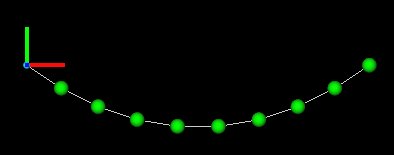
Download, decompress and run massSpring.zip.
The
programs displays a string of particles and springs. Type CTRL+SPACE to
perform one time step, or SPACE to animate continuously.
question Integration Complete the implementation of the integration scheme (update of positions and velocities) in the update() function of the particle system. Once this is done, notice that you can interactively drag particles using the mouse andSHIFT+LEFT-CLICK
question Fixed object The fixed particle does not move because it has been assigned a null mass. Explain the trick used to obtain fixed objects using a null mass
question Divergence
The explicit integration scheme can not avoid divergence for high
stiffnesses or large computation times. Dump images and produce a short video which
illustrates this.
To improve the stability, implement a viscous force proportional and opposed to the velocity of each particle: f=-air_damping*v where v is the velocity of the particle and air_damping is a positive value.
question Air damping Give one example of motion for
which the consequences of air damping and spring damping differ
significantly. Shoot two short videos to illustrate the difference, and
explain.
